Nobody likes getting stung by an insect, but it’s important to remember that stinging insects such as bees, wasps, and ants play a number of important roles in the ecosystem:
- They pollinate flowers as they move from one plant to another. Many plants rely on stinging insects for pollination and would not be able to reproduce without them.
- They are a significant food source for other insects, birds, reptiles, and mammals.
- They are important predators, helping to control pest populations by feeding on insects that can damage crops and plants.
- They are key indicators of the health of the ecosystem. Changes in their populations or behavior can be an early warning sign of environmental problems, such as pollution or habitat destruction.
Even though stinging insects play a vital role in the natural balance, none of us wants to get on the wrong end of their stingers! Read on to discover our pics for 10 of the most painful insect stings, what to do if you get stung, and how to get rid of stinging insects from areas where they can be a danger to people.
1. Bullet Ant
World’s Most Painful Insect, the bullet ant, is named for its extremely potent sting (Paraponera clavata) from Costa Rica.
©Dan Olsen/Shutterstock.com
The bullet ant is at the top of nearly every expert’s list as the most painful of all insect stings. Native to Central and South America, this is one of the largest ant species in the world, reaching a length of 1.2 inches. It got its name because people who have experienced its sting say it feels like a gunshot, with waves of burning, excruciating pain that can last for 24 hours and get even more painful over time. In addition to sheer agony, victims can experience fever, nausea, trembling, and cardiac arrhythmia.
Fortunately, they are generally not considered an aggressive species. Unfortunately, when they do sting someone, they release a chemical that signals all their friends to go into a stinging frenzy. Believe it or not, one Brazilian tribe uses these ants as a rite of passage for teenage boys, making them prove their manhood by wearing a glove with bullet ants affixed, stingers pointed inward, without showing any sign of pain. What do you think? Want to join the tribe?
2. Tarantula Hawk
Tarantula Hawks are such dangerous wasps that they are often seen consuming a tarantula spider.
©Sari ONeal/Shutterstock.com
The tarantula hawk is a large, colorful wasp found in many parts of the world, including North, Central, and South America and parts of Asia. It is most commonly found in tropical and subtropical regions and is adapted to living in humid, warm environments. It is known for its bright colors, which are often shades of blue, purple, or red. It is also known for its large size, with some species reaching lengths of up to 2 inches.
The tarantula hawk is a predatory wasp and feeds on a variety of insects, including tarantulas, up to eight times its own weight. It overcomes them by stinging and paralyzing them with venom before dragging its kill back to its nest. The tarantula hawk is a solitary wasp and is not aggressive toward humans. However, it will sting if threatened or provoked, and its sting is said to be extremely painful–nearly as painful as the bullet ant. It’s been described as a sharp, electric shock-like sensation that can last several hours
3. Warrior Wasp
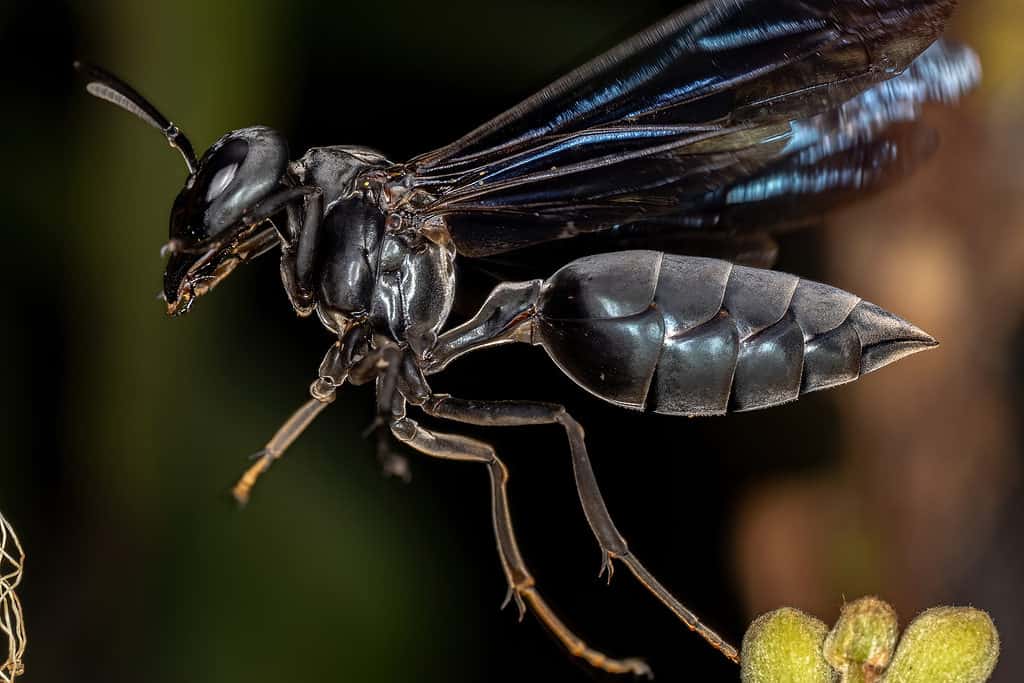 Warrior wasps have black or dark blue bodies with metallic-like shades.
Warrior wasps have black or dark blue bodies with metallic-like shades.
©iStock.com/ViniSouza128
The warrior wasp is an aggressive, territorial paper wasp species found in tropical parts of South America. It gets its name because of a fear-inducing practice: when the nest is threatened, the whole hive will beat their wings in rhythm, sounding remarkably like marching troops. Warrior wasps grow up to an inch long and have powerful jaws and a potent sting. Their venom contains a chemical called poneratoxin, which produces severe shooting pain and swelling. People stung by this species often require medical attention, especially as these wasps often defend their nest as a terrifying swarm.
4. Velvet Ant
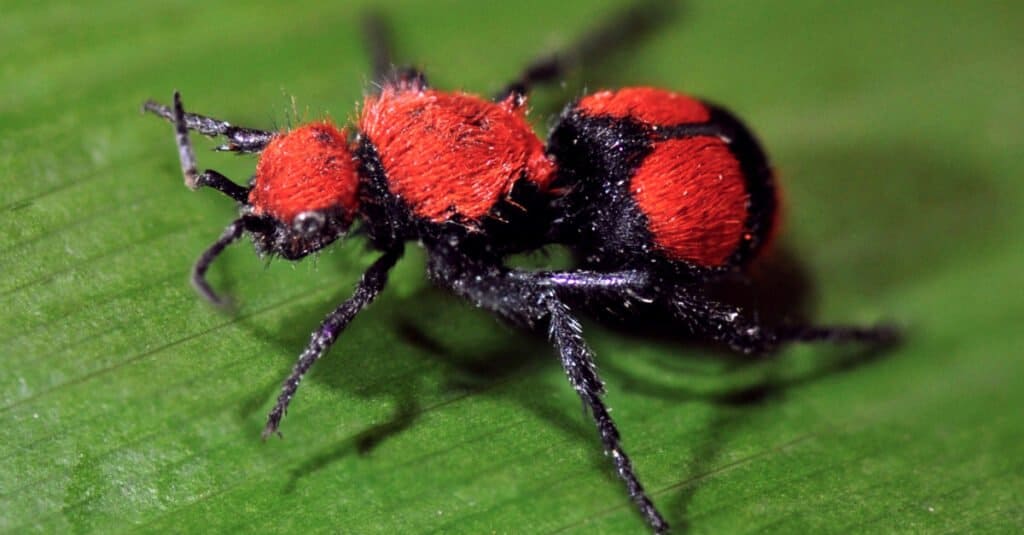 The Velvet ant’s sting is not toxic to humans or other mammals but causes intense agony that has been compared to being stabbed or hit with shrapnel.
The Velvet ant’s sting is not toxic to humans or other mammals but causes intense agony that has been compared to being stabbed or hit with shrapnel.
©Tarsal Claw/Shutterstock.com
Velvet ants are not really ants at all but are colorful wingless female wasps with black bodies covered in soft-looking red, yellow, orange, or brown hairs. If you live in the southern or southwestern United States, you’re most likely to see one–or step on one–when it emerges from its burrow to seek a mate. Some people have described the velvet ant as “cuddly” looking, so you might be tempted to pet it–but that would be a mistake you would not make twice! The insect’s sting is not toxic to humans or other mammals but causes intense agony that has been compared to being stabbed or hit with shrapnel.
Velvet ants are also called “cow killers.” This name is an exaggeration–their sting cannot literally kill a cow, but legends from the Old West tell of cows stepping in a nest and breaking a leg while running away frantically, or of stings on a cow getting infested with maggots. Deadly or not, and whether you’re a cow or a person–you don’t want to mess with this ant-that-is-a-wasp.
5. Paper Wasp
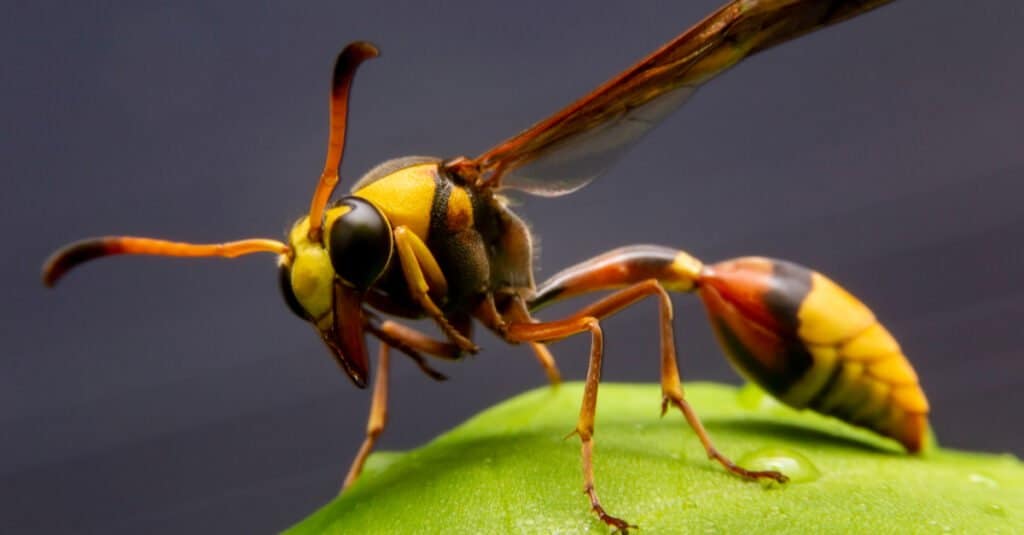 Paper wasps have a tendency to form nests under the eaves and in the attics of houses.
Paper wasps have a tendency to form nests under the eaves and in the attics of houses.
©Witsawat.S/Shutterstock.com
There are over 1,000 species of paper wasps found all over the world. Paper wasps get their name from the nests they build out of saliva and wood fibers molded into thin paper-like layers. Undisturbed, their nests can get huge and house colonies of over 200 wasps. They are often found in trees and shrubs in the wild, but they also tend to form nests under the eaves and in the attics of houses and other areas protected from the elements.
They are generally not aggressive, but when they feel they are threatened, the entire hive can attack en masse with stings that have been described as being “like a drop of superheated frying oil” dripped on your skin. Although the sting is not highly toxic, it may produce burning pain, swelling, redness, and itching at the site of the sting that can last for several hours.
6. Florida Harvester Ant
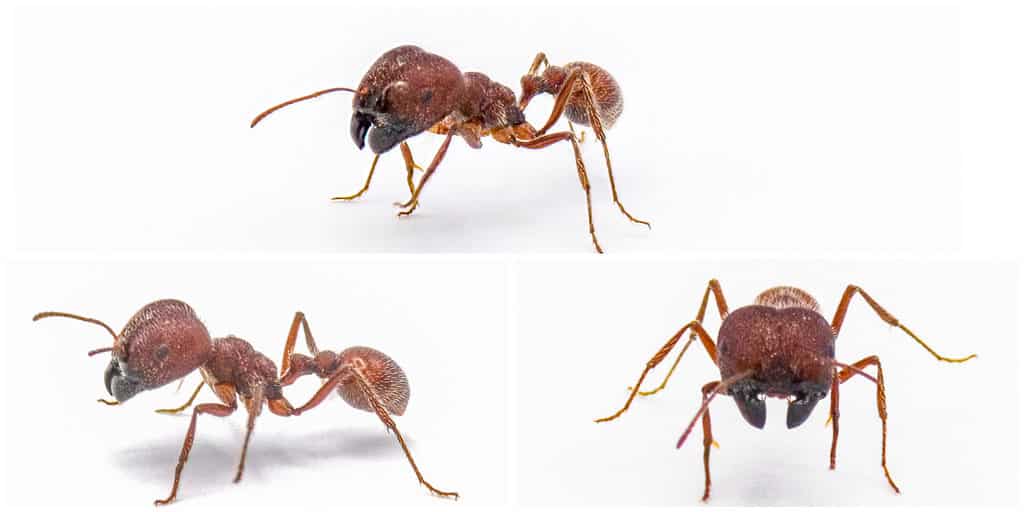 The Florida harvester ant is a species in the Pogonomyrmex genus.
The Florida harvester ant is a species in the Pogonomyrmex genus.
©iStock.com/Dan Rieck
The term “harvester ant” applies to any ant species that gather seeds or mushrooms and stores them in granary chambers as food for the colony. This activity can be very beneficial to the ecosystem by disbursing and planting seeds and aerating the soil. Harvester ants are native to North America, but the only species found east of the Mississippi River is the Florida Harvester ant. Their stings are reputed to be one of the most painful of any ant species in the world. The pain lasts several hours, causing swelling and a watery, oozy secretion from the site of the sting.
7. Fire Ant
 The sting of a fire ant is typically very painful, with a sharp, stinging sensation that can last for several hours.
The sting of a fire ant is typically very painful, with a sharp, stinging sensation that can last for several hours.
©Lukas Jonaitis/Shutterstock.com
Fire ants are a type of stinging ant that is indigenous to South America but has spread to many other parts of the world (including North America, Europe, Asia, and Australia) as stowaways in international trade and travel. In the United States, they are prevalent in southern and southwestern states. They are typically found in a variety of habitats, including forests, grasslands, and agricultural areas, and are often active in and around homes. Because of their aggressive behavior and proximity to people, they are considered a major pest.
The sting of a fire ant is typically very painful, with a sharp, stinging sensation that can last for several hours. Some people have described the pain as feeling like a burn or a hot poker. The venom of a fire ant contains a chemical called solenopsin, which can cause irritation and inflammation at the site of the sting. Oh, and if by chance you live on an island, don’t think being surrounded by water will keep you safe–fire ants can link their bodies together to make massive floating islands to cross bodies of water!
8. Africanized Honey Bee
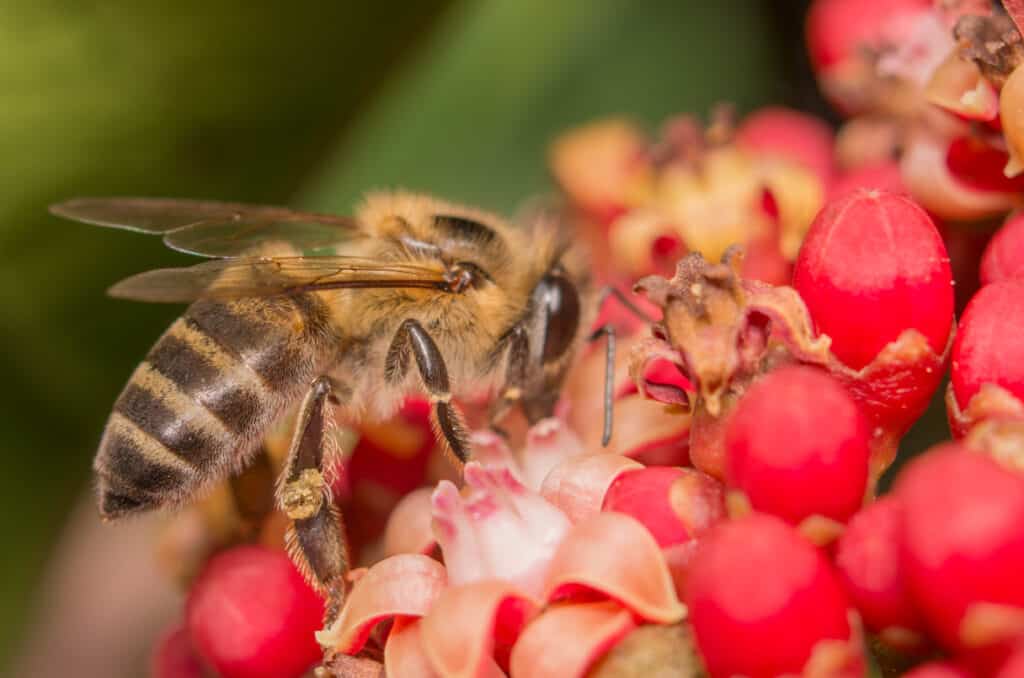 Africanized honey bees are known for being highly aggressive, swarming, pursuing, and relentlessly stinging people or animals that get near their nests.
Africanized honey bees are known for being highly aggressive, swarming, pursuing, and relentlessly stinging people or animals that get near their nests.
©Philip Marsden/Shutterstock.com
Africanized honey bees, also known as “killer bees,” are the unfortunate result of a science experiment gone dreadfully wrong. In the 1950s, researchers brought hardy, aggressive African honey bees to Brazil to use in experimental breeding programs. Disastrously, some escaped and began interbreeding with local populations of more docile European honey bees. The hybrid species went on to spread across South and Central America and into the southwestern and southern United States.
Africanized honey bees are known for being highly aggressive, swarming, pursuing, and relentlessly stinging people or animals that get near their nests. Their sting itself is not particularly toxic, but it is sharp and painful. Large numbers of stings can cause life-threatening physiological reactions. Locations of nests should be reported to professionals for removal as this species is a danger to people and animals in their range.
9. Japanese Giant Hornet
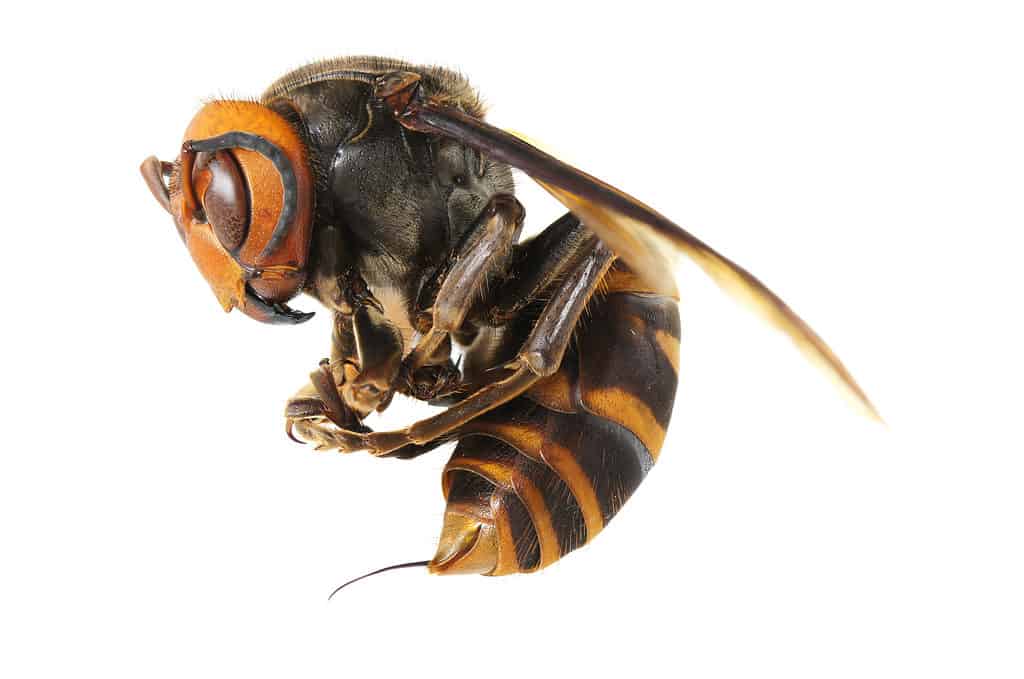 The venom of the Japanese giant hornet contains mandaratoxin, which can cause damage to the tissue around the sting site, including swelling, redness, and itching.
The venom of the Japanese giant hornet contains mandaratoxin, which can cause damage to the tissue around the sting site, including swelling, redness, and itching.
©Contrail/Shutterstock.com
The Japanese giant hornet, also known as the Asian Giant Hornet, is the largest hornet in the world at 1 and 3/4 inches long and with a wingspan of 3 inches. It is found in East Asia and the Russian Far East, but from 2019-2021 began to appear in the Pacific Northwest of the United States and Canada. This was likely the result of international travel and trade. Researchers found no reports of them the following year, leading to hope they had been eradicated.
This species packs a powerful sting that creates an extremely painful, sharp, burning sensation that can last for several hours. The venom of the Japanese giant hornet contains mandaratoxin, which can cause damage to the tissue around the sting site, including swelling, redness, and itching. Some people also experience nausea when stung by this terrifyingly large insect.
10. Yellowjacket
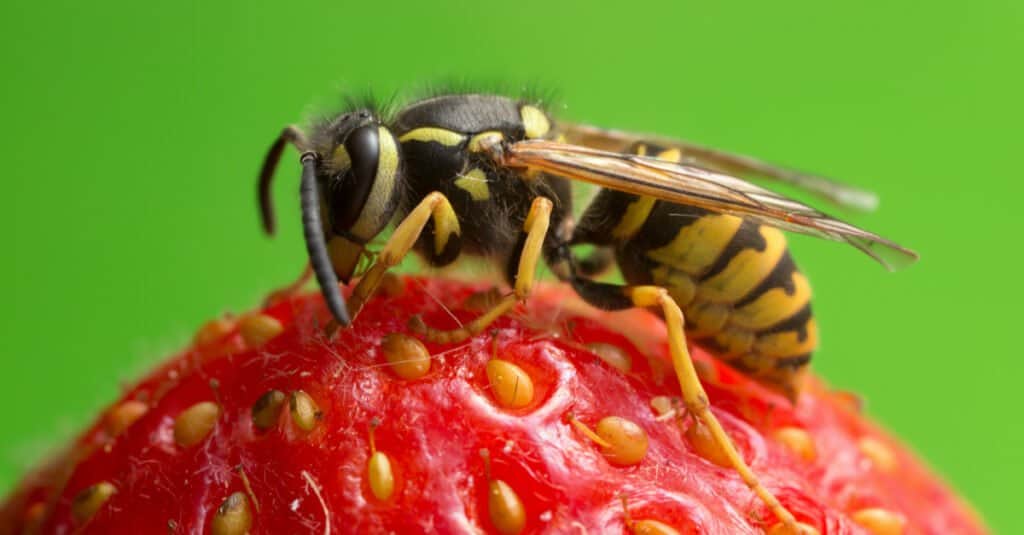 Unlike bees, whose stingers detach from their bodies after stinging, yellowjackets keep their stingers and can sting their victim multiples times, a capability they readily use.
Unlike bees, whose stingers detach from their bodies after stinging, yellowjackets keep their stingers and can sting their victim multiples times, a capability they readily use.
©Henrik Larsson/Shutterstock.com
Yellowjacket is a term for various small predatory wasp species in North America. They are characteristically black and yellow, often in alternating bands, and they have a unique way of flying rapidly side-to-side before landing. They may build nests in the ground, in trees, or in hidden protected places such as barns or attics. Even though they helpfully prey on some harmful insect species, they also like many of the same foods humans do. It’s not unusual to find yellow jackets hovering around trashcans or attempting to sample your bottle of soda on a hot summer day.
Yellowjacket stings are not as painful as the other insects on our list, but they are still more than enough to ruin a perfectly good day at the park, especially if you are attacked by multiple individuals. Their stings produce a burning and itching sensation that can last a couple of hours and can produce allergic reactions in some people.
They have been described as having an “angry disposition” because of their habit of going on the attack unprovoked and pursuing people even when they try to steer clear of them and their nests. Unlike bees, whose stingers detach from their bodies after stinging, yellowjackets keep their stingers and can sting their victim multiples times, a capability they readily use. Yellowjackets can also bite, but it is not clear whether they use that ability against humans or only when feeding. So next time you see something buzzing around a public trashcan . . . you might just want to cross the street.
What to Do if You Get Stung
If you are stung by an insect, here are a few steps you can take to help reduce the pain and swelling:
- Remove the stinger: If the stinger is still in the skin, try to remove it as soon as possible. Scrape the stinger out with a sanitized fingernail, credit card, or knife. Avoid squeezing the stinger, as this can cause more venom to be released.
- Wash the area: Use soap and water to clean the area where you were stung. This will help to prevent infection.
- Apply a cold pack: Place a cold pack or a bag of ice on the area where you were stung. This will help to reduce swelling and numb the area.
- Take over-the-counter pain medication: If the pain is severe, you may want to take an over-the-counter pain medication.
- Apply an over-the-counter cream: There are a variety of creams that are designed to help reduce the pain and swelling of insect stings. Look for a cream that contains hydrocortisone or another anti-inflammatory ingredient.
- Watch for signs of an allergic reaction: Some people may have a severe allergic reaction to insect stings. If you experience difficulty breathing, chest tightness, hives, or swelling of the face, lips, or tongue, seek medical attention immediately.
- It is also a good idea to keep an eye on the bite site for any signs of infection, such as redness, swelling, or pus. If you notice any of these symptoms, you should contact a healthcare professional.
How Can You Remove Stinging Insects?
No one wants stinging insects in or near their property or public areas where people might get hurt. Here are some of the preventative measures you can take before they become a problem:
- Remove potential food sources from the property. Fruit that has fallen from trees, hummingbird feeders, and even pet food can all attract a variety of pests.
- When eating outdoors, cover food and drinks and put away leftovers and dirty dishes as soon as possible.
- Seal outdoor trash cans and compost piles. Rotting food, especially meats and sweets, are like an all-you-can-eat buffet to wasps and yellowjackets.
- Eliminate entrances to your home. Closed doors and windows are only half the battle. Be sure even the smallest of cracks and crevices are sealed to prevent wasps from entering your home.
- Fill any holes in the ground. This is key in preventing in-ground nests. If you have a large property, prioritize the areas closest to your home and most often frequented by people and pets.
If you already have a problem with individual stinging insects or nests on your property, here are some possible ways to remove them.
- Traps: Use traps to catch the insects. There are a variety of traps available, including sticky traps, pheromone traps, and bait traps.
- Vacuum: It’s possible to use a vacuum cleaner to suck up small numbers of insects. Be sure to seal up and dispose of the vacuum bag immediately after use to prevent the insects from escaping. Do not attempt this on an entire hive, which should be handled by a professional.
- Natural remedies: Use natural remedies, such as peppermint oil or citrus oil, to repel the insects. Simply mix a few drops of the oil with water and spray the mixture in the areas where the insects are found.
- Insecticide: Use an insecticide spray to kill the insects. Be sure to follow the instructions on the label carefully and use caution when applying the insecticide, as some products can be toxic to humans and pets. Because of potential environmental impact, this may not be a preferred choice.
- Professional pest control: If you are dealing with an entire nest or if you or a member of your family is highly allergic, it is best to hire a professional pest control company. They will have the knowledge, experience, and equipment needed to remove the insects safely, effectively, and in the most ecologically responsible way.









